Forest Hills—Turns out there’s more to lunchtime at Central Woodlands fifth- and sixth-grade school than maybe people realize.
From heading to the cafeteria to cleaning up and going back to class, so many steps are involved that it is remarkable that the weekday ritual usually comes off as smoothly as it does.
But as sixth-graders shared recently, there’s always room for improvement. And they, the experts at sixth-grade lunch, are key to coming up with ways to make it better.
“My understanding of school lunchtime is from, like, 45 years ago, so your input is highly valuable to this process,” said Derek Fricano, UX design team lead at Open Systems Technologies.
Fricano led about 50 sixth-graders through a design thinking exercise, just like he does at work.
“If people tell you lunchtime is broken, we lay out the process step by step, then go step by step to see what really works, what kind-of works and what doesn’t work, so we know which steps we agree need the most attention.”
Having done that, students focused on dismissal from lunch, which they overwhelmingly agreed could stand to be more efficient.
No idea was too outrageous to start, Fricano told one group.
Guen Kimber-Keene’s advice: “Dismiss more quickly.”
One girl said: “Mrs. Tolly makes us do the Macarena before we can go.”

Said another: “Let’s tell people they have to moonwalk out (of the cafeteria).”
Nathan Stanard thought a leftover-eating dog might help speed up the process, but classmate Mia Hoffman introduced what design thinkers call a constraint: “My cousin is scared of dogs,” she said.
Leveraging Connections
OST was one of five companies that sent representatives to the school recently to lead hands-on activities that show how STEM concepts are involved in their jobs every day.
“I wanted to do this event for several reasons, the first being that I love giving my students opportunities that they wouldn’t normally get in my day-to-day teaching,” said Central Woodlands teacher Patricia Tolly.
“I want students to see how what they are learning is relevant to the rest of their lives. I think it is so important for students to hear from a variety of people how what they are doing in school has real-life applications.”
Other companies were Gordon Food Service, Wolverine Worldwide, GE Aviation and the U.S. Nuclear Regulatory Commission. Activities included flying simple drones in the gymnasium, creating an image to be turned into a non-fungible token to show how the food industry uses blockchain technology and “controlled computer hacking” to introduce the concept of cybersecurity.
Leverage Connections
Tolly was approached about the event by parent Lisa Fricano, who works for GFS and had led a similar event in Kentwood. She and Ginger Rohwer, regional director of the MiSTEM Network of Greater West Michigan, are leading a research effort on K-12 STEM programs for the West Michigan Technology Task Force.
The wider goal is to make Grand Rapids a destination for tech companies and talent. Fricano said all it took was tapping her growing network of contacts and even school parents like herself and her husband, Derek, who led the design thinking activity and was very impressed with his lunchtime brainstorming charges.
‘I could probably go on with a million reasons why I wanted to do this, but I truly just want my kids to go home and talk about what they learned in school and say what a cool day it was and how much they learned.’
“They have been absolutely, wonderfully engaged,” he said. “Forest Hills has obviously already done a lot of preparation with them around design thinking, so I’m fortunate to work with kids who already have a ground-level understanding of how this works.
“The more we can help people understand that constructive critique leads to better solutions… it’s about understanding that we live within really complex systems, and that we can help our learners know that they inhabit a world that influences and is influenced by those systems.”
Added Tolly: “I could probably go on with a million reasons why I wanted to do this, but I truly just want my kids to go home and talk about what they learned in school and say what a cool day it was and how much they learned.
“If this sparks interest in any of my students for something that they never considered before, then it is a success. I would love them to find an interest in technology that started in sixth grade.”




